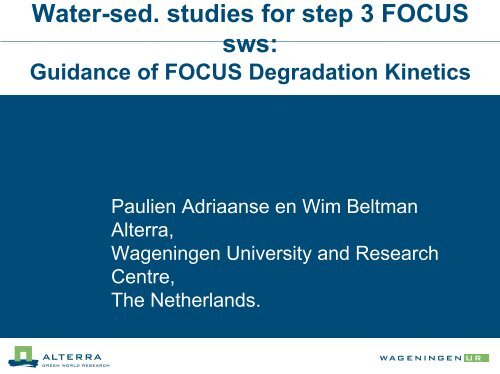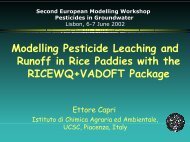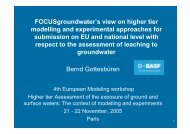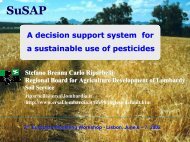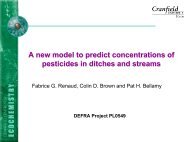guidance of FOCUS degradation kinetics - pfmodels
guidance of FOCUS degradation kinetics - pfmodels
guidance of FOCUS degradation kinetics - pfmodels
Create successful ePaper yourself
Turn your PDF publications into a flip-book with our unique Google optimized e-Paper software.
Water-sed. studies for step 3 <strong>FOCUS</strong><br />
sws:<br />
Guidance <strong>of</strong> <strong>FOCUS</strong> Degradation Kinetics<br />
•<br />
Paulien Adriaanse en Wim Beltman<br />
Alterra,<br />
Wageningen University and Research<br />
Centre,<br />
The Netherlands.
Introduction<br />
• <strong>FOCUS</strong> Surface Water Scenarios since May 2003<br />
• Tiered approach to assess aquatic exposure<br />
• Input needed: pesticide properties and appln<br />
pattern<br />
• One <strong>of</strong> most difficult: <strong>degradation</strong> in water and in<br />
sediment<br />
• Present approach Deg Kinetics + conclusions<br />
new development with TOXSWA + conclusions
Introduction<br />
• When are <strong>degradation</strong> rates in water and in<br />
sediment important input ?<br />
(NOT for simple peaks after spray drift or ro/dr)<br />
1. Chronic exposure<br />
2. Peak caused by accumulation <strong>of</strong><br />
concentrations in case <strong>of</strong> multiple applications<br />
on waterbodies with high residence times<br />
3. Upscaling above the edge-<strong>of</strong>-field level<br />
(transport times)
Introduction<br />
• Basis for <strong>degradation</strong> rates:<br />
water-sediment study:<br />
test tubes in lab,<br />
controlled conditions,<br />
radio-labelled compound for:<br />
- <strong>degradation</strong> pathways and<br />
- persistence in surface water<br />
(mass measured in water and in sediment)
Introduction
Introduction<br />
• Necessary background:<br />
volatilisation<br />
XXX<br />
<strong>degradation</strong><br />
<strong>degradation</strong><br />
diffusion<br />
sorption<br />
DOC,<br />
ss<br />
sorption<br />
sed<br />
• So, dissipation DT50 ≠ DegT50 !
Introduction<br />
• Degradation rates: hard to estimate well<br />
• <strong>FOCUS</strong> Deg Kinetics: <strong>guidance</strong><br />
draft report 16 Jan for comment <strong>of</strong> MS this spring<br />
• Guidance for use in step 3 <strong>FOCUS</strong> sws (level P-II),<br />
not for triggers,<br />
parent only
Guidance <strong>FOCUS</strong> Degradation Kinetics<br />
• Level P-II: 2 procedures are needed<br />
1. Fit data water-sed study with SFO model<br />
2. Check obtained rates with TOXSWA runs for<br />
water-sed study
Guidance <strong>FOCUS</strong> Degradation<br />
Kinetics
Guidance <strong>FOCUS</strong> Degradation<br />
Kinetics<br />
• Fit SFO<br />
• Fit water and sediment<br />
simultaneously<br />
• Fit 4 (or 3) parameters:<br />
k wc , k sed , r wc (r sed )<br />
STEP 1:<br />
Assume reversible<br />
partitioning.<br />
SFO appropriate?<br />
• Modify fitting routine<br />
stepwise:<br />
1. Exclude outliers<br />
2. Constrain M0<br />
3. Weighting<br />
Deviation from SFO due to<br />
experimental<br />
artifact/decline in microbial<br />
activity? - See text<br />
• Constrain fitting <strong>of</strong> kwc<br />
and/or ksed<br />
conservatively, using<br />
results obtained<br />
at Level P-I and expert<br />
judgement (see text)<br />
Data entry<br />
M0 free, use all data, no weighting<br />
Simultaneous fit <strong>of</strong> <strong>kinetics</strong> to observed data in water column and sediment<br />
No<br />
RUN<br />
SFO<br />
SFO statistically and visually<br />
acceptable?<br />
RUN<br />
SFO<br />
modified and/or constrained<br />
fitting routines<br />
SFO statistically and visually<br />
acceptable?<br />
(modified and/or constrained fitting<br />
routine)<br />
Yes<br />
Yes<br />
STOP<br />
Use SFO results for<br />
modelling at Steps 2 and<br />
3 in <strong>FOCUS</strong> SW<br />
STOP<br />
Use SFO results (modified<br />
and/or constrained fitting<br />
routine) for modelling at<br />
Steps 2 and 3 in <strong>FOCUS</strong> SW<br />
• Fit untill good fit:<br />
visual and statistical<br />
if necessary with constraints<br />
set by experts<br />
STEP 2:<br />
Assume non-reversible partitioning<br />
if justifiable.<br />
SFO appropriate?<br />
STOP<br />
See text (10.2.5 and 10.2.6)<br />
No<br />
No<br />
Repeat from top <strong>of</strong> scheme but assume<br />
non-reversible partitioning.<br />
As above, start with M0 free, all data, no<br />
weighting, and no constraints.<br />
Modify/constrain fitting routines as necessary.<br />
RUN<br />
SFO<br />
SFO statistically and visually<br />
acceptable?<br />
Yes<br />
STOP<br />
Use SFO results for<br />
modelling at Steps 2 and<br />
3 in <strong>FOCUS</strong> SW
Guidance <strong>FOCUS</strong> Degradation<br />
Kinetics<br />
• Particular attention if estimated values zero<br />
Behaviour in other studies (adsorption, hydrolysis,<br />
aerobic or unaerobic soil studies)<br />
Likely unrealistic -> redo fitting<br />
• Three examples : 1 or 2 parameters (k) are 0<br />
Not likely-> expert sets constraints and redoes<br />
fitting
Guidance <strong>FOCUS</strong> Degradation<br />
Kinetics<br />
• 4 th example: Compound absorbing weakly to<br />
sediment<br />
Step 1a<br />
Step 1b<br />
• DegT50 in wc: ∞ 26.1 d<br />
• in sed: 1.8 4.3 d
Guidance <strong>FOCUS</strong> Degradation<br />
Kinetics<br />
• Step 1a not acceptable (based on former work),<br />
so, take step 1b<br />
• So, proposed fitting method alone seems not<br />
robust<br />
• Possible reason: 4 parameters to be fitted at<br />
the same time, several solutions possible ?
Guidance <strong>FOCUS</strong> Degradation<br />
Kinetics<br />
• Check if level P-II degr.rates in TOXSWA describe<br />
reasonably water-sed experiment<br />
Level P-II: transfer water-sed 1 st order<br />
TOXSWA: transfer diffusion (Fick) + sorption to<br />
sed.<br />
• If no good match with TOXSWA:<br />
3 steps procedure to redo fitting with TOXSWA<br />
coupled to PEST
Examples<br />
• Compound 4, K oc,soil = 224 L/kg<br />
Concentration (mg/L)<br />
Concentration (mg/dm 3 )<br />
0.005<br />
Measured<br />
Level P-II Error 5.1 %<br />
K OC<br />
Error 5.5 %<br />
DegT50 Error 2.8 %<br />
KOC & DegT50<br />
0.001<br />
Measured<br />
Level P-II Error 22%<br />
KOC Error 28%<br />
DegT50 Error 6.3%<br />
K OC<br />
& DegT50 Error 6.4%<br />
0.000<br />
0 1 2<br />
0.000<br />
0 1 2<br />
Time (d)<br />
Time (d)
Examples<br />
• Errors, compound 4, K oc,soil = 224 L/kg<br />
Difference (mg/L)<br />
0.001<br />
Difference (mg/dm 3 )<br />
0.001<br />
0.000<br />
0.000<br />
-0.001<br />
0 1 2<br />
-0.001<br />
0 1 2<br />
Time (d)<br />
Time (d)
Examples<br />
• Compound 3, K oc,soil = 76 000 L/kg<br />
Concentration (mg/L)<br />
Concentration (mg/dm 3 )<br />
0.015<br />
Measured<br />
Level P-II Error 9.7 %<br />
KOC Error 16 %<br />
DegT50 Error 17 %<br />
KOC & DegT50 Error 20 %<br />
0.025<br />
Measured<br />
Level P-II Error 22%<br />
KOC Error 28%<br />
DegT50 Error 6.3%<br />
KOC & DegT50 Error 6.4%<br />
0.000<br />
0 5 10 15<br />
0.000<br />
0 20 40 60 80 100<br />
Time (d)<br />
Time (d)
Examples<br />
• Errors, compound 3, K oc,soil = 76 000 L/kg<br />
Difference (mg/L)<br />
0.0025<br />
Difference (mg/dm 3 )<br />
0.0025<br />
0.0000<br />
0.0000<br />
-0.0025<br />
0 5 10 15<br />
-0.0025<br />
0 20 40 60 80 100<br />
Time (d)<br />
Time (d)
Examples<br />
• Results level P-II and TOXSWA-PEST<br />
DegT50 for water column and for sediment<br />
System Level P-II Optimisations TOXSWA-PEST<br />
Deg.rates Deg.rates & Koc<br />
Compound 3<br />
Koc 76 000 L/kg (soil) - 80 769 L/kg (sed)<br />
Water 3.79 d 0.84 d 0.81 d<br />
Sediment 50.6 d 590 d 395 d<br />
Compound 4<br />
Koc 224 L/kg (soil) - 143 L/kg (sed)<br />
Water 0.29 d 0.36 d 0.35 d<br />
Sediment 0.30 d 0.03 d 0.03 d
Conclusions (1)<br />
• 2 methods give different results, esp. for <strong>degradation</strong><br />
rate in sediment<br />
• no clear <strong>guidance</strong> on what to select for <strong>FOCUS</strong> sws<br />
• entire procedure is laborious (2 models) and needs<br />
expert judgement<br />
• is fitting with TOXSWA only an acceptable option ?
Demonstration fitting with TOXSWA<br />
• New development, TOXSWA coupled to PEST<br />
• Use only TOXSWA instead <strong>of</strong> SFO model +<br />
TOXSWA<br />
• Fit in 2 steps:<br />
1. K oc,sed =K oc,soil , optimise DegT50 for water and<br />
sediment<br />
2. Optimise K oc,sed , both DegT50s simultaneously<br />
with range set for K oc,sed<br />
(e.g. ½-2 K oc,soil )
Fitting with TOXSWA<br />
• Advantages <strong>of</strong> using TOXSWA:<br />
• physical basis<br />
• standardized, no expert judgement needed<br />
• 3 instead <strong>of</strong> 4 parameters to fit, (<strong>of</strong> which 1<br />
uses info from soil studies)<br />
• also used in <strong>FOCUS</strong> sws
Fitting with TOXSWA<br />
• Disadvantages <strong>of</strong> TOXSWA:<br />
• User-friendliness <strong>of</strong> fitting procedure ?<br />
• No solution for DegT50s <strong>of</strong> metabolite
Fitting with TOXSWA<br />
• Parameterise TOXSWA for water-sediment system:<br />
- system dimensions, sed properties<br />
- pesticide properties<br />
• Parameterise PEST (2x):<br />
- select parameters<br />
- give water and sediment data equal weights<br />
• Run TOXSWA, coupled to PEST (2x)<br />
• Examine graphical output
Fitting with TOXSWA<br />
• At present: TOXSWA 1.2 coupled to PEST used<br />
(Annex 11 <strong>of</strong> <strong>FOCUS</strong> Deg Kin report)<br />
• From summer 2004 in: <strong>FOCUS</strong>_TOXSWA_2.2.2<br />
( = <strong>FOCUS</strong>-TOXSWA_1.1.1 plus<br />
- current bugs repaired and<br />
- simulation <strong>of</strong> water-sediment studies made easier<br />
(coupled to PEST))
Create project (copy example water-sed)
Two runs to optimise
Parameterise system (ca 10 values)
Parameterise substance (ca 8 values)
Close TOXSWA application
Run PEST coupled to TOXSWA<br />
• Parameterise TOXSWA_to_PEST application:<br />
- enter all measured data (equal weight)<br />
• - 1. enter K oc,soil , 2 initial DegT50s+range<br />
- 2. enter K oc,soil +range, 2 initial DegT50s+range<br />
• Start optimising 2 or 3 parameters<br />
• Extract results (DegT50s, K oc,sed plus uncertainty:<br />
errors, confidence intervals,..)
Conclusions (2)<br />
• TOXSWA is straightforward<br />
(no reliance on expert judgement)<br />
- straightforward ≠ correct !,<br />
assumptions in model concept, K oc,soil ≈K oc,sed<br />
b.d., porosity, ..<br />
• Visual comparison remains important<br />
(<strong>degradation</strong> lines + fit errors)<br />
• Both methods laborious + not simple -> decision tree on need<br />
for water-sediment study analysis would help


